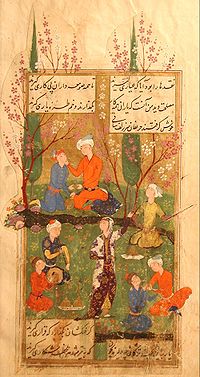The influence of Persian literature on World literature
Published: March 10, 2016

William Shakespeare referred to Iran as the “land of the Sophy”. Some of Persia’s best-beloved medieval poets were Sufis, and their poetry was, and is, widely read by Sufis from Morocco to Indonesia. Rumi (Maulānā) in particular is renowned both as a poet and as the founder of a widespread Sufi order. The themes and styles of this devotional poetry have been widely imitated by many Sufi poets.
Many notable texts in Persian mystic literature are not poems, yet highly read and regarded. Among those are Kimiya-yi sa’ādat and Asrar al-Tawhid.
Afghanistan and the Transoxiana can claim to be the birthplace of Modern Persian. Most of the great patrons of Persian literature such as Sultan Sanjar and the courts of the Samanids and Ghaznavids were situated in this region, as were writers such as Rudaki, Unsuri, and Ferdowsi. As such, this rich literary heritage continues to survive well into the present in countries like Tajikistan, Uzbekistan and Afghanistan.
With the emergence of the Ghaznavids and their successors such as the Ghurids, Timurids and Mughal Empire, Persian culture and its literature gradually moved into the vast Indian subcontinent. Persian was the language of the nobility, literary circles, and the royal Mughal courts for hundreds of years. (In modern times, Persian has been generally supplanted by Urdu, a heavily Persian-influenced dialect of Hindustani.)
Under the Moghul Empire of India during the sixteenth century, the official language of India became Persian. Only in 1832 did the British army force the Indian subcontinent to begin conducting business in English. (Clawson, p.6) Persian poetry in fact flourished in these regions while post-Safavid Iranian literature stagnated. Dehkhoda and other scholars of the 20th century, for example, largely based their works on the detailed lexicography produced in India, using compilations such as Ghazi khan Badr Muhammad Dehlavi’s Adat al-Fudhala Ibrahim Ghavamuddin Farughi’s Farhang-i Ibrahimi, and particularly Muhammad Padshah’s Farhang-i Anandraj. Famous South Asian poets and scholars such as Amir Khosrow Dehlavi, Mirza Ghalib and Muhammad Iqbal of Lahore found many admirers in Iran itself.
Persian literature was little known in the West before the nineteenth century. It became much better known following the publication of several translations from the works of late medieval Persian poets, and it inspired works by various Western poets and writers.
- In 1819, Goethe published his West-östlicher Divan, a collection of lyric poems inspired by a German translation of Hafiz (1326–1390).
- The German essayist and philosopher Nietzsche was the author of the book Thus Spoke Zarathustra (1883–1885), referring to the ancient Persian prophet Zoroaster (circa 1700 BCE).
- A selection from Ferdowsi’s Shahnameh (935–1020) was published in 1832 by James Atkinson, a physician employed by the British East India Company.
- A portion of this abridgment was later versified by the British poet Matthew Arnold in his 1853 Rustam and Sohrab.
- The American poet Ralph Waldo Emerson was another admirer of Persian poetry. He published several essays in 1876 that discuss Persian poetry: Letters and Social Aims, From the Persian of Hafiz, and Ghaselle.
Perhaps the most popular Persian poet of the nineteenth and early twentieth centuries was Omar Khayyam (1048–1123), whose Rubaiyat was freely translated by Edward Fitzgerald in 1859. Khayyam is esteemed more as a scientist than a poet in his native Persia, but in Fitzgerald’s rendering, he became one of the most quoted poets in English. Khayyam’s line, “A loaf of bread, a jug of wine, and thou”, is known to many who could not say who wrote it, or where.
The Persian poet and mystic Rumi (1207–1273) (known as Molana in Iran) has attracted a large following in the late twentieth and early twenty-first centuries. Popularizing translations by Coleman Barks have presented Rumi as a New Age sage. There are also a number of more literary translations by scholars such as A.J. Arberry.
The classical poets (Hafiz, Sa’di, Khayyam, Rumi, Nezami and Ferdowsi) are now widely known in English and can be read in various translations. Other works of Persian literature are untranslated and little known.
During the last century, numerous works of classical Persian literature have been translated into Swedish by baron Eric Hermelin. He translated works by, among others, Farid al-Din Attar, Rumi, Ferdowsi, Omar Khayyam, Sa’adi and Sana’i. Influenced by the writings of the Swedish mystic Emanuel Swedenborg, he was especially attracted to the religious or Sufi aspects of classical Persian poetry.
More recently Rumi, Hafiz, Fakhruddin ‘Iraqi and Nizami Aruzi are available in translation by Ashk Dahlén, scholar in Iranian Studies, who has made Persian literature known to a wider audience in Sweden.
During the last century, numerous works of classical Persian literature have been translated into Italian by Alessandro Bausani (Nizami, Rumi, Iqbal, Khayyam), Carlo Saccone (‘Attar, Sana’i, Hafiz, Nasir-i Khusraw, Nizami, Ahmad Ghazali), Angelo Piemontese (Amir Khusraw Dihlavi), Pio Filippani-Ronconi (Nasir-i Khusraw, Sa’di), Riccardo Zipoli (Kay Ka’us, Bidil), Maurizio Pistoso (Nizam al-Mulk), Giorgio Vercellin (Nizami ‘Aruzi), Giovanni Maria D’Erme (‘Ubayd Zakani, Hafiz), Sergio Foti (Suhrawardi, Rumi, Jami), Rita Bargigli (Sa’di, Farrukhi, Manuchehri, ‘Unsuri). A complete translation of Firdawsi’s Shah-nama was made by Italo Pizzi in XIX century.
